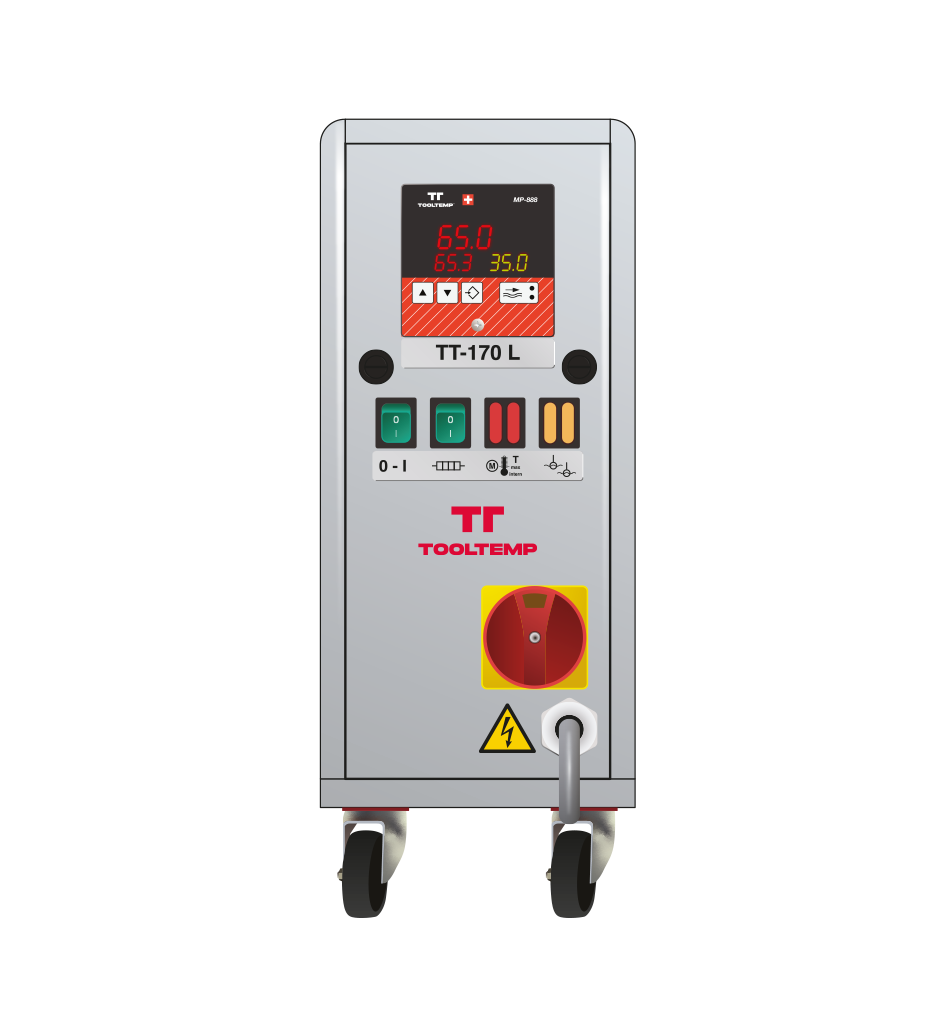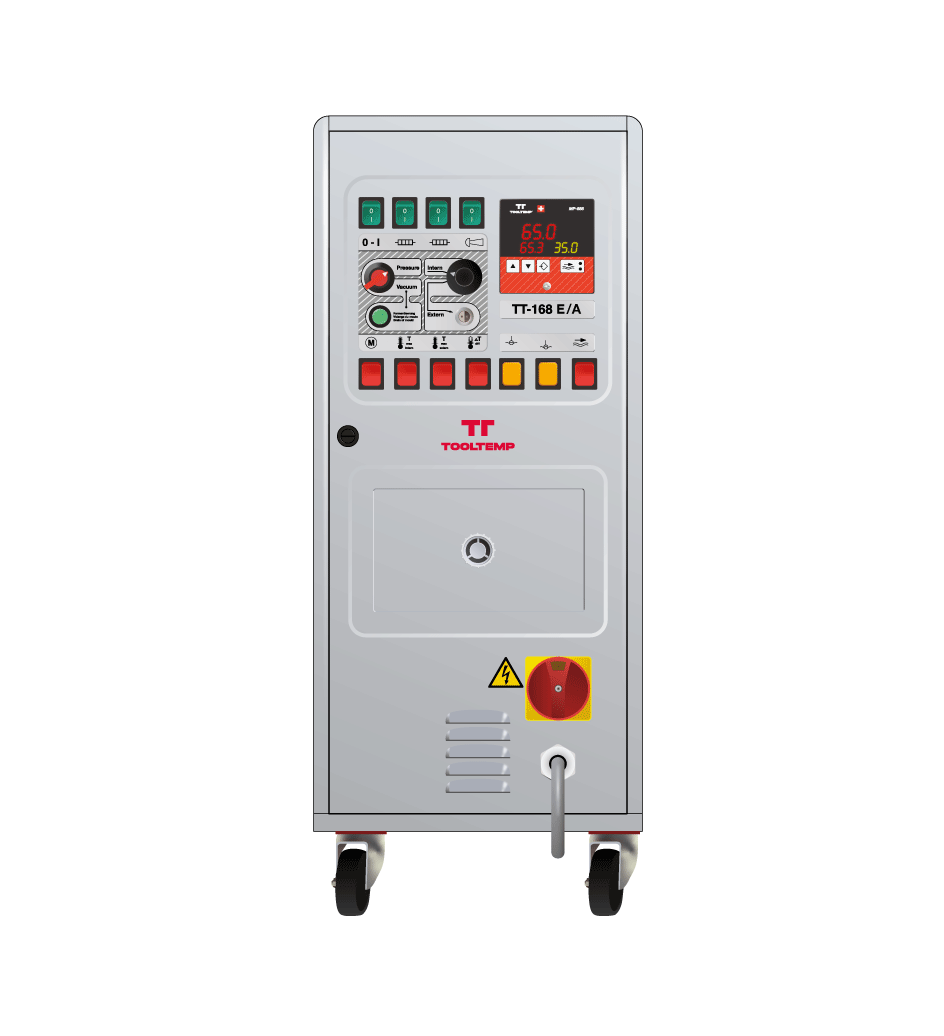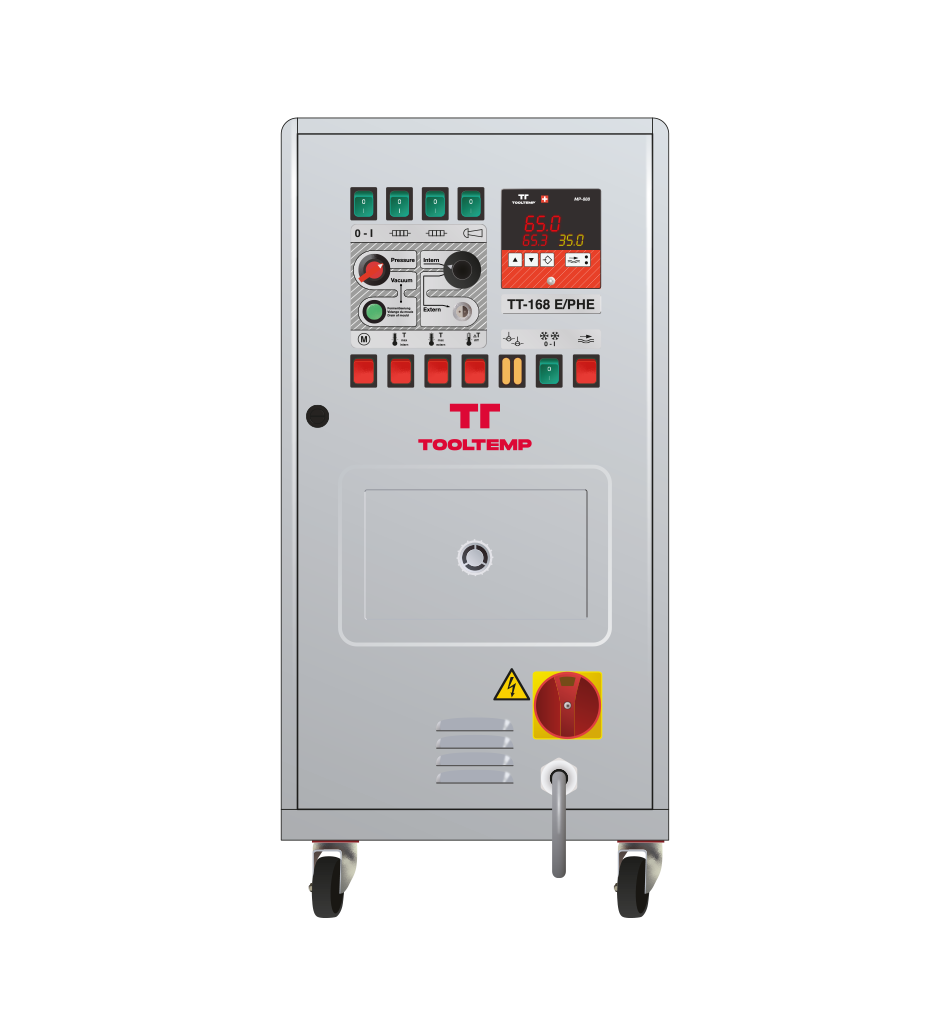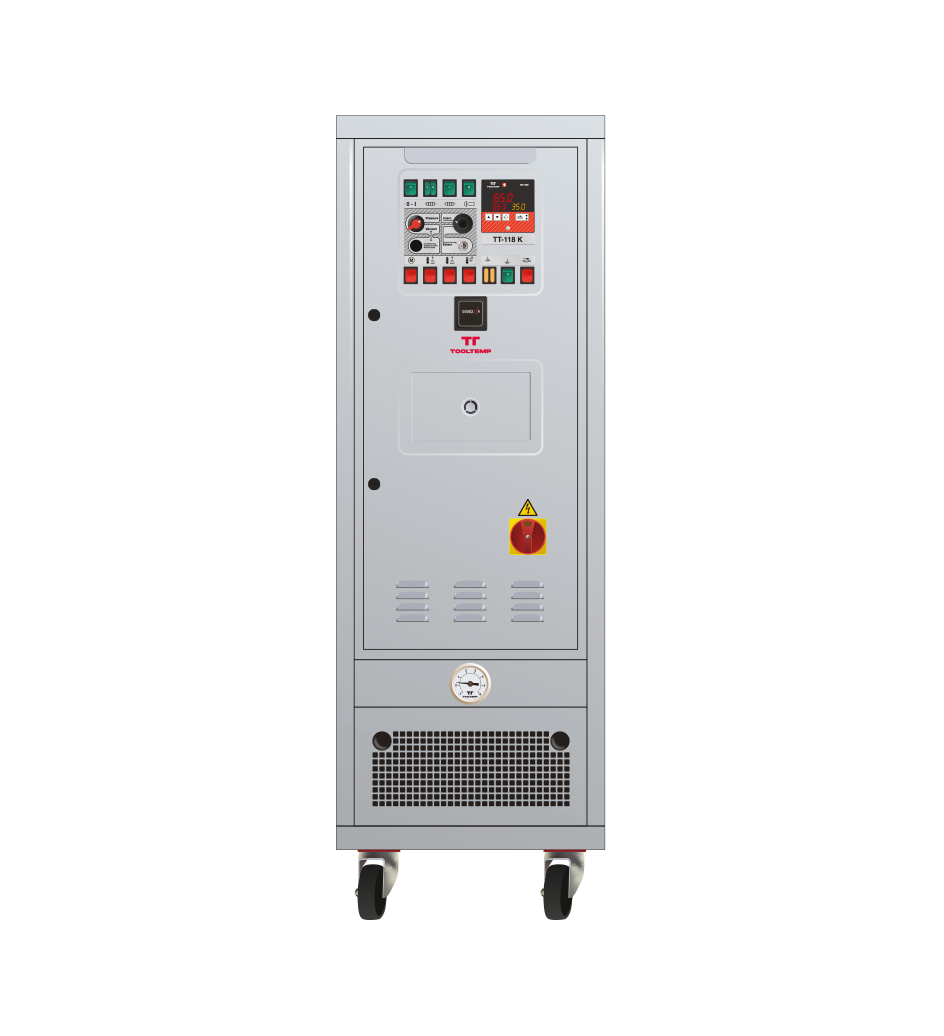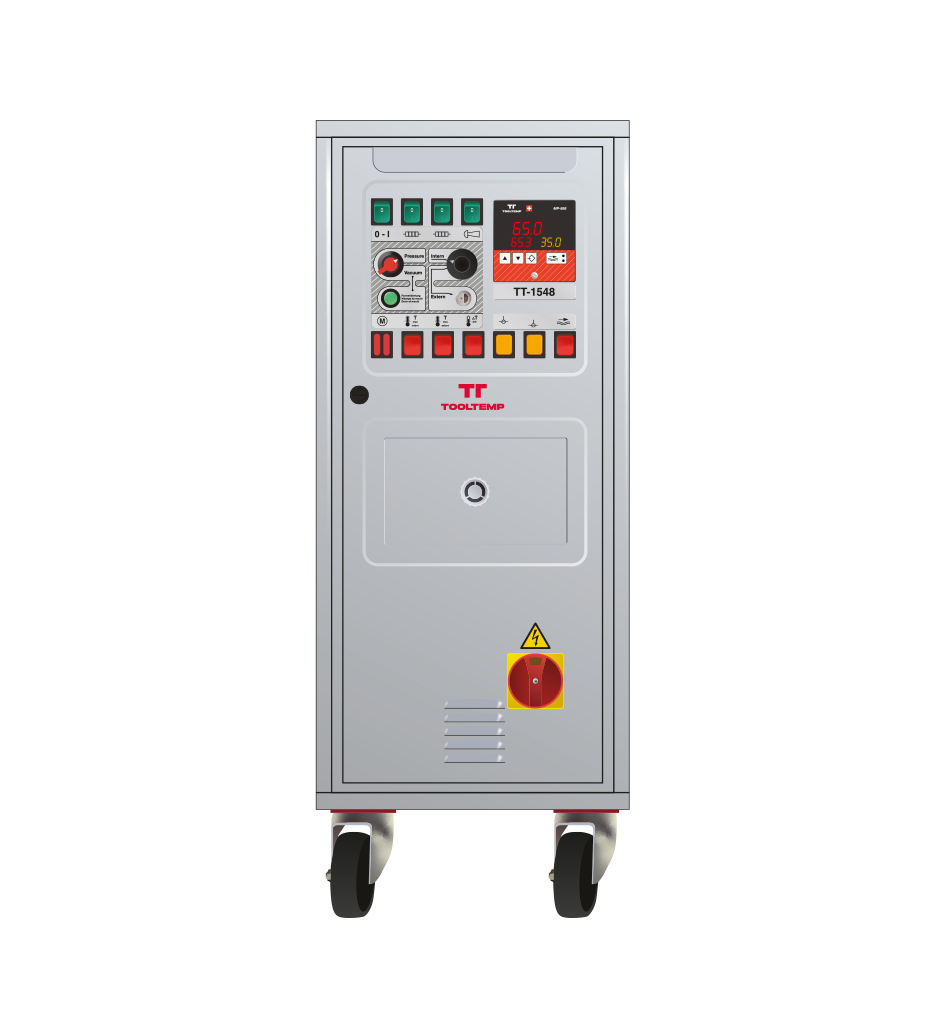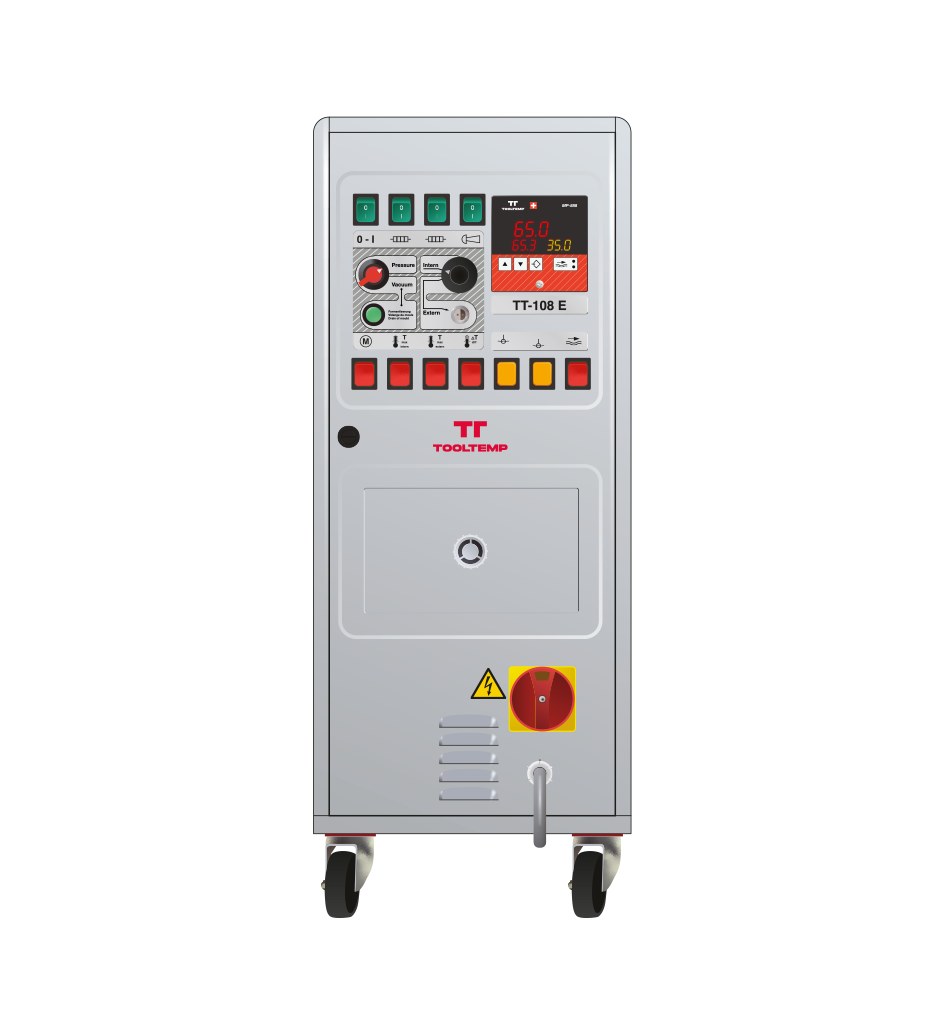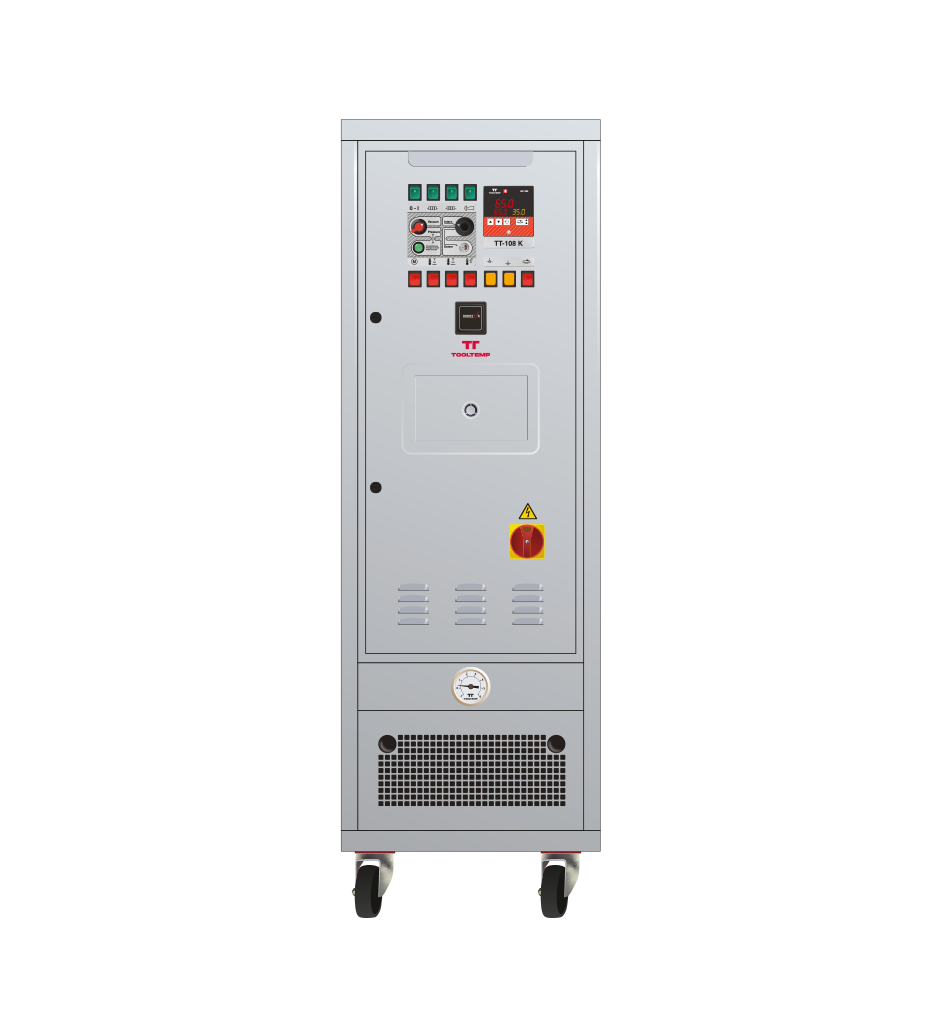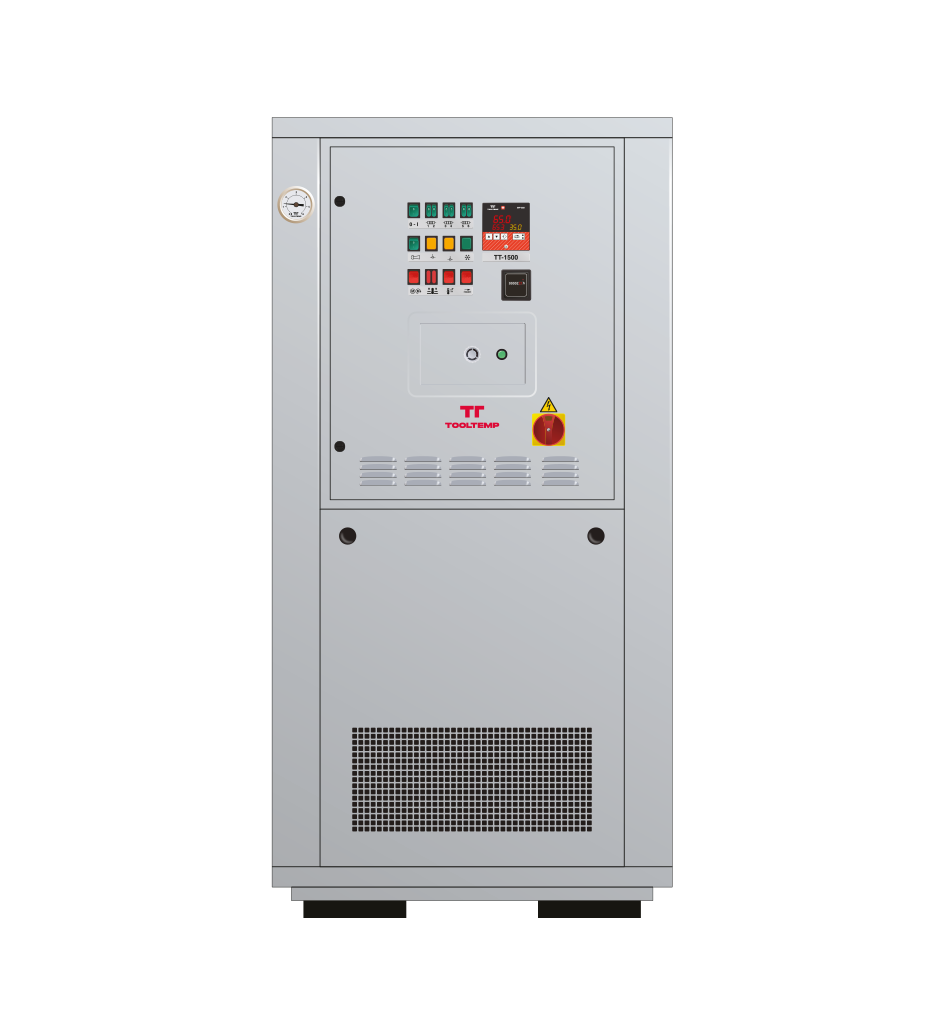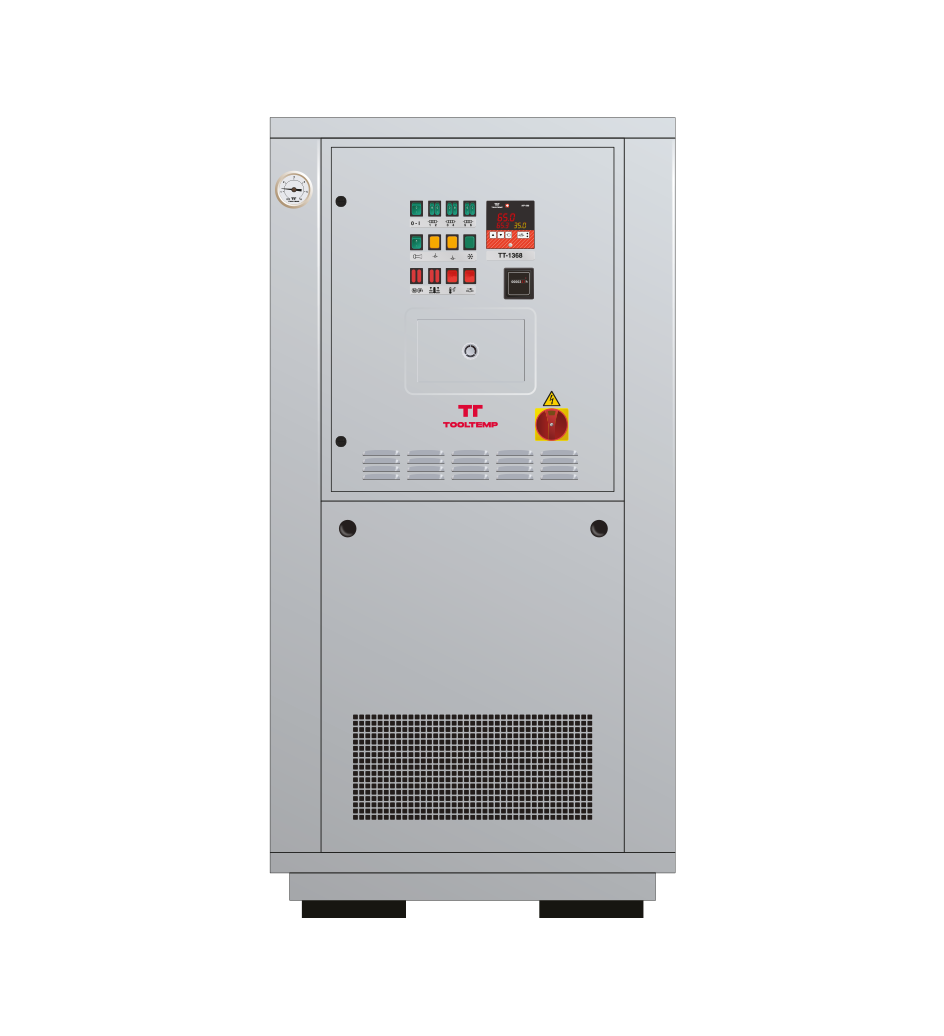- |
- Products
- |
- Water Temperature Control Units
Water temperature control unitsup to 90°C
All Tool-Temp water temperature control units have a maximum temperature of 90 °C. However, they each have different designs depending on the intended application. Temperature control units for water can be divided into four general categories. Details can be found further down this page.
- Open systems – indirect cooling
- Open systems – direct cooling
- Closed systems – indirect cooling
- Closed systems – direct cooling
TT-170 L
- Maximum temperature 90°C
- Heating capacity 3 kW
- Cooling capacity 30 kW @ 90°C
- Cooling system indirect
- Pump capacity 28 l/min;
max. 2.8 bar - Medium water
Moulds up to 50 kg, rollers up to 80 mm Ø, length 300 mm
TT-168 E/A I TT-168 H/A
- Maximum temperature 90°C
- Heating capacity 18 kW
- Cooling capacity 45 kW @ 90°C
- Cooling system indirect
- Typ E: Pump capacity 60 l/min; max. 4.0 bar
- Typ H: Pump capacity 60 l/min; max. 7.0 bar
- Medium water
Moulds up to 1'800 kg
TT-168 PHE
- Maximum temperation 90°C
- Heating capacity
12 kW I 18 kW - Cooling capacity
50 kW @ 90°C indirect
130 kW @ 90°C PHE - Cooling system indirect
- Type E: pump capacity 60 l/min;
max. 4.0 bar - Type H: Pumo capacity 60 l/min;
max. 7.0 bar - Medium water
12 kW: Moulds up to 1'200 kg / 18 kW: Moulds up to 1'800 kg
TT-118 K
- Maximum temperature 90°C
- Heating capacity: 18 kW I 27 kW l 36 kW l 45 kW
- Cooling capacity
200 kW @ 90°C indirect
400 kW @ 90°C direct - Cooling system indirect
- Pump capacity 200 l/min;
max. 4.3 bar - Medium water
Roller, plates, double-walled vessels, large consumers
TT-1548 E
- Maximum temperature 90°C
- Heating capacity 12 kW
- Cooling capacity 5 kW @ 70°C
- Cooling system air-cooled
- Pump capacity 60 l/min;
max. 4.0 bar - Medium water
Rotary table systems, Applications without cooling water
TT-108 E
- Maximum temperature 90°C
- Heating capacity
6 kW I 12 kW I 18 kW - Cooling capacity 100 kW @ 90°C
- Cooling system direct
- Pump capacity 60 l/min;
max. 4.0 bar - Medium water
Moulds, plates
TT-108 K
- Maximum temperature 90°C
- Heating capacity
18 kW I 27 kW I 36 kW I 45 kW - Cooling capacity 260 kW @ 90°C
- Cooling system direct
- Pump capacity 200 l/min;
max. 4.3 bar - Medium water
Moulds, plates
TT-1500 W
- Maximum temperature 90°C
- Heating capacity 48 kW
- Cooling capacity 285 kW @ 80°C
- Cooling system direct
- Pump capacity 250-350 l/min;
max. 4.5 bar - Medium water
Rollers, plates, double walled vessels, large consumers
TT-1368 W
- Maximum temperature 90°C
- Heating capacity
24 kW I 48 kW I 72 kW I 96 kW - Cooling capacity 400 kW @ 70°C
- Cooling system indirect
- Pump capacity 250-350 l/min;
max. 4.5 bar - Medium water
Rollers, plates, double-walled vessels, large consumers
TT-1368 V
- Maximum temperature 90°C
- Heating capacity
72 kW I 96 kW I 144 kW - Cooling capacity 400 kW @ 80°C
- Cooling system indirect
- Pump capacity 580 l/min;
max. 4.1 bar - Medium water
Rollers, plates, double-walled vessels, large consumers
Product range overview -water temperature control units
| Product | TT-170 L | TT-168 E/A I H/A - 18 kW | TT-168 PHE | |
|---|---|---|---|---|
| Temperature range | °C | 90 | 90 | 90 |
| Heat transfer medium | water | water | water | |
| Filling amount max. | l | 5 | 20 | 20 |
| Heating capacity | kW | 3 | 18 | 12 I 18 |
| Cooling system | indirect | indirect | indirect | |
| tubular heat exchanger | kW | 30 | 45 | 50 |
| Plate heat exchanger | kW | 130 | ||
| Direct | kW | |||
| At flow temperature | °C | 90 | 90 | 90 |
| Pump system see diagram | ||||
| Typ L: 19 l/min; max. 2.9 bar; motor 0.27 kW | ⚫ | |||
| Typ E: 60 l/min; max. 4.0 bar; motor 0.75 kW | ⚫ | ⚫ | ||
| Typ H: 60 l/min; max. 7.0 bar; motor 1.50 kW | ⚫ | ⚫ | ||
| Typ K: 200 l/min; max. 4.3 bar; motor 2.2 kW | ||||
| Typ W: 250-350 l/min; max. 4.5 bar; motor 4.0 kW | ||||
| Typ V: 580 l/min; max. 4.1 bar; motor 7.5 kW | ||||
| Suction capacity vakuum | mWS | - | 8 | 8 |
| Controller | MP-888 | |||
| Measurement type | FeKo Typ J | |||
| Connections | ||||
| Medium | 3/8" BS | 1/2" BS | 3/4" BS | |
| Cooling water | 3/8" BS | 3/8" BS | 1" BS | |
| Compressed air | - | - | - | |
| Dimensions incl. castors, LxWxH | mm | 640x200x490 | 710x325x785 | 980x365x750 |
| Weight empty approx. | kg | 36 | 67 | 90 |
| Colour | silvergrey RAL 7001 | |||
| Functions | ● standard/ ○ optional / - not possible | |||
| Flow control | - | ⚫ | ⚫ | |
| Leakstopper device | - | ⚫ | ⚫ | |
| Mould drain | - | ⚫ | ⚫ | |
| Temperature control at the consumer | - | ⚫ | ⚫ | |
| Time limited water refill | - | ⚫ | ⚫ | |
| Interface controller | - | ◯ | ◯ | |
| Automatic refill | ⚫ | ⚫ | ⚫ | |
| Level control | ⚫ | ⚫ | ⚫ | |
| Visual fault indications | ⚫ | ⚫ | ⚫ | |
| Acoustic warning | ⚫ | ⚫ | ⚫ | |
| Pressure regulation | - | - | - | |
| Go to product | Go to product | Go to product | ||
| Product | TT-118 K | TT-1548 E | TT-108 E | |
|---|---|---|---|---|
| Temperature range | °C | 90 | 90 | 90 |
| Heat transfer medium | water | water | water | |
| Filling amount max. | l | 40 | 20 | 20 |
| Heating capacity | kW | 18 kW I 27 kW I 36 kW I 45 kW | 12 | 6 kW I 12 kW I 18 kW |
| Cooling system | indirect | air-cooled | direct | |
| tubular heat exchanger | kW | 200 | 5 | |
| Plate heat exchanger | kW | 400 | ||
| Direct | kW | 100 | ||
| At flow temperature | °C | 90 | 70 | 90 |
| Pump system see diagram | ||||
| Typ L: 19 l/min; max. 2.9 bar; motor 0.27 kW | ||||
| Typ E: 60 l/min; max. 4.0 bar; motor 0.75 kW | ⚫ | ⚫ | ||
| Typ H: 60 l/min; max. 7.0 bar; motor 1.50 kW | ||||
| Typ K: 200 l/min; max. 4.3 bar; motor 2.2 kW | ⚫ | |||
| Typ W: 250-350 l/min; max. 4.5 bar; motor 4.0 kW | ||||
| Typ V: 580 l/min; max. 4.1 bar; motor 7.5 kW | ||||
| Suction capacity vakuum | mWS | 8 | 8 | 8 |
| Controller | MP-888 | |||
| Measurement type | FeKo Typ J | |||
| Connections | ||||
| Medium | 1" BS | 3/4" BS | 1/2" BS | |
| Cooling water | 1" BS | Inlet 3/8" BS Outlet 1" BS | ||
| Compressed air | - | - | - | |
| Dimensions incl. castors, LxWxH | mm | 1240x480x1400 | 870x360x915 | 710x325x785 |
| Weight empty approx. | kg | 180 | 95 | 67 |
| Colour | silvergray RAL 7001 | |||
| Functions | ● standard/ ○ optional / - not possible | |||
| Flow control | ⚫ | ⚫ | ⚫ | |
| Leakstopper device | ⚫ | ⚫ | ⚫ | |
| Mould drain | - | ⚫ | ⚫ | |
| Temperature control at the consumer | ⚫ | ⚫ | ⚫ | |
| Time limited water refill | ⚫ | - | - | |
| Interface controller | ◯ | ◯ | ◯ | |
| Automatic refill | ⚫ | - | ⚫ | |
| Level control | ⚫ | ⚫ | ⚫ | |
| Visual fault indications | ⚫ | ⚫ | ⚫ | |
| Acoustic warning | ⚫ | ⚫ | ⚫ | |
| Pressure regulation | - | - | - | |
| Go to product | Go to product | Go to product | ||
| Product | TT-108 K | TT-1500 W | TT-1368 W | |
|---|---|---|---|---|
| Temperature range | °C | 90 | 90 | 90 |
| Heat transfer medium | water | water | water | |
| Filling amount max. | l | 40 | 75 | 70/100 |
| Heating capacity | kW | 18 I 27 I 36 I 45 | 48 | 24 kW I 48 kW I 72 kW I 96 kW |
| Cooling system | direct | direct | indirect | |
| tubular heat exchanger | kW | |||
| Plate heat exchanger | kW | 400 | ||
| Direct | kW | 260 | 285 | |
| At flow temperature | °C | 90 | 80 | 70 |
| Pump system see diagram | ||||
| Typ L: 19 l/min; max. 2.9 bar; motor 0.27 kW | ||||
| Typ E: 60 l/min; max. 4.0 bar; motor 0.75 kW | ||||
| Typ H: 60 l/min; max. 7.0 bar; motor 1.50 kW | ||||
| Typ K: 200 l/min; max. 4.3 bar; motor 2.2 kW | ⚫ | |||
| Typ W: 250-350 l/min; max. 4.5 bar; motor 4.0 kW | ⚫ | ⚫ | ||
| Typ V: 580 l/min; max. 4.1 bar; motor 7.5 kW | ||||
| Suction capacity vakuum | mWS | 8 | - | - |
| Controller | MP-888 | |||
| Measurement type | FeKo Typ J | |||
| Connections | ||||
| Medium | 1" BS | Flansch DN32 / PN16 | flange DN32 / PN16 | |
| Cooling water | Inlet 1/2" BS Outlet 1 1/2" BS | 1" BS | 1 1/2" BS | |
| Compressed air | - | 1/4" BS | - | |
| Dimensions incl. castors, LxWxH | mm | 1250x480x1400 | 1600x800x1550 | 1710x790x1540 / 2150x1300x1950 |
| Weight empty approx. | kg | 160 | 430 | 520/850 |
| Colour | silvergrey RAL 7001 | |||
| Functions | ● standard/ ○ optional / - not possible | |||
| Flow control | ⚫ | ⚫ | ⚫ | |
| Leakstopper device | ⚫ | - | - | |
| Mould drain | ⚫ | ⚫ | - | |
| Temperature control at the consumer | ⚫ | - | - | |
| Time limited water refill | - | - | - | |
| Interface controller | ◯ | ◯ | ◯ | |
| Automatic refill | ⚫ | ⚫ | ⚫ | |
| Level control | ⚫ | ⚫ | ⚫ | |
| Visual fault indications | ⚫ | ⚫ | ⚫ | |
| Acoustic warning | ⚫ | ⚫ | ⚫ | |
| Pressure regulation | - | ◯ | ◯ | |
| Go to product | Go to product | Go to product | ||
| Product | TT-1368 V | |
|---|---|---|
| Temperature range | °C | 90 |
| Heat transfer medium | water | |
| Filling amount max. | l | 100 |
| Heating capacity | kW | 72 kW I 96 kW I 144 kW |
| Cooling system | indirect | |
| tubular heat exchanger | kW | |
| Plate heat exchanger | kW | 400 |
| Direct | kW | |
| At flow temperature | °C | 80 |
| Pump system see diagram | ||
| Typ L: 19 l/min; max. 2.9 bar; motor 0.27 kW | ||
| Typ E: 60 l/min; max. 4.0 bar; motor 0.75 kW | ||
| Typ H: 60 l/min; max. 7.0 bar; motor 1.50 kW | ||
| Typ K: 200 l/min; max. 4.3 bar; motor 2.2 kW | ||
| Typ W: 250-350 l/min; max. 4.5 bar; motor 4.0 kW | ||
| Typ V: 580 l/min; max. 4.1 bar; motor 7.5 kW | ⚫ | |
| Suction capacity vakuum | mWS | - |
| Controller | MP-888 | |
| Measurement type | FeKo Typ J | |
| Connections | ||
| Medium | flange DN32 / PN16 | |
| Cooling water | 1 1/2" BS | |
| Compressed air | - | |
| Dimensions incl. castors, LxWxH | mm | 2150x1300x1950 |
| Weight empty approx. | kg | 915 |
| Colour | silvergrey RAL 7001 | |
| Functions | ● standard/ ○ optional / - not possible | |
| Flow control | ⚫ | |
| Leakstopper device | - | |
| Mould drain | - | |
| Temperature control at the consumer | - | |
| Time limited water refill | - | |
| Interface controller | ◯ | |
| Automatic refill | ⚫ | |
| Level control | ⚫ | |
| Visual fault indications | ⚫ | |
| Acoustic warning | ⚫ | |
| Pressure regulation | ◯ | |
| Go to product | ||
Water temperature control units -function and operation explained
Water temperature control units from Tool-Temp are differentiated into open and closed systems. A further difference is the type of cooling used. In water units up to 90 °C, indirect cooling systems using a heat exchanger as well as direct cooling systems are also used. In open systems, the circulation medium comes into direct contact with the air in the local environment. This uses an open tank heating system in which the tank also acts as an expansion reservoir. Closed systems, on the other hand, have an expansion tank for equalising the volume.
An immersion pump, usually a rotary pump, is mounted to the water tank. The cooling water circulates through a spiral-shaped cooling tube located in the tank, around which the heat carrier flows. Indirectly cooled units like these have a solenoid valve that opens when cooling is required to allow the cooling water to flow through the heat exchanger. The cooling water inlet can be attached to either a cooling unit or to the mains water supply. The heating units are immersion heaters which are situated in the tank and around which the medium then flows. A temperature sensor measures the temperature of the heat carrier and passes the value to the regulator. Tool-Temp uses type J (Fe-Ko) thermal elements as the temperature sensor in these models. The level is controlled using a float in the tank that automatically activates a switch if the liquid level gets too low. This switch interrupts the pump and heat relay circuits (dry run protection). A safety thermostat interrupts the heat relay circuit once the maximum inlet temperature has been reached.
The cooling system used in water temperature control units from Tool-Temp is what truly makes them stand out. Almost all temperature control systems that handle water up to 90 °C feature a double cooling design to achieve maximum cooling capacity at the various operating points. In addition to a pipe bundle or spiral heat exchanger, large plate heat exchangers are used for a temperature range of 25 to 50 °C. The units therefore provide huge cooling capacity across the 25 – 90 °C range and allow materials with a wide range of different temperature requirements to be processed. Each cooler is optimised to the respective temperature range in order to guarantee a long service life and ensure robustness.
Unlike open systems with indirect cooling, temperature control systems with direct cooling do not have a heat exchanger. When cooling is activated, a solenoid valve opens, allowing cooling water to flow directly into the water tank. The process water mixes with the cooling water and excess medium flows out of the tank. With this type of design, it is important that the cooling water drain does not exert any counterpressure so that water can flow out quickly enough and not move back into the open tank and cause it to overflow.
Design
These systems are designed much like open systems with indirect cooling. An immersion pump, usually a rotary pump, is mounted to the water tank. Units with direct cooling have a solenoid valve that opens when cooling is required to allow the cooling water to flow directly into the water tank. The cooling water mixes with the process water and excess water flows out of the unit via a drain. The cooling water inlet can be attached to either a cooling unit or to the mains water supply. The heating units are immersion heaters which are situated in the tank and around which the medium then flows. A temperature sensor measures the temperature of the heat carrier and passes the value to the regulator. Tool-Temp uses type J (Fe-Ko) thermal elements as the temperature sensor in these models. The level is controlled using a float in the tank that automatically activates a switch if the liquid level gets too low. This switch interrupts the pump and heat relay circuits (dry run protection). A safety thermostat interrupts the heat relay circuit once the maximum inlet temperature has been reached.
The design of this group of units is very simple and therefore an attractive option for price-sensitive products. However, the advantages of this type of construction – high cooling capacity, simple design, easy to maintain – can only be effectively used if the unit is integrated into the overall design of the system. This includes having a cooling water outlet line with zero counterpressure. Ideally, the cooling water should be collected in a basin or tank and then be recycled. This external water tank should ideally feature fill level monitoring and a pump system that can shift the water to a central cooling plant or to the temperature control unit if cooling is required. Unlike our other models, much more careful consideration is required for integrating these units into a system. For applications that do not require cooling, this range of units is ideal since no expensive connections are needed and the unit falls into a very attractive price bracket.
Tool-Temp heating and cooling systems for up to 90 °C with an integrated expansion tank further feature a high flow rate and heating power starting from 48 kW. This type of unit is designed for applications with large rollers, calenders, plates, double-walled containers and reactors. The advantage of this system is that it allows temperature control for consumers with large volume return flows. This series is primarily used in the chemical and pharmaceutical industries. This units also have uses in the recycling and rubber processing sectors.
Design
Water units up to 90 °C with a semi-open tank design are equipped with an inline pump. These models feature a high capacity expansion tank that can handle the return flow volumes from large consumers. The unit monitors both the minimum and maximum fill levels, triggering an alert if there is any deviation from these values. Electrical heating elements are located in the tank, where the circulation medium then flows around them. These models use exclusively large plate heat exchangers. This ensures that they have the capacity to handle the huge cooling requirements of chemical processing systems. When cooling is activated, a solenoid valve opens, allowing cooling water to flow through the plate heat exchanger. The process medium begins to lose temperature from its surface. For optimum results, a sufficiently large cooling water supply is required.
Tool-Temp uses type J (Fe-Ko) thermal elements as the temperature sensor in these models. The level is controlled using a float in the tank that automatically activates a switch if the liquid level gets too low. This switch interrupts the pump and heat relay circuits (dry run protection). A safety thermostat interrupts the heat relay circuit once the maximum inlet temperature has been reached.
The large design of the water tank provides these units with a very large return flow volume. Thanks to the use of inline pumps that can handle flow rates of up to 500 l/min, there is sufficient circulation to ensure perfect regulation.
This heating and cooling system features a very simple design with excellent performance. The device has a large inline pump and a tank in which the heating elements are mounted. The tank design is fully enclosed, similar to a pressurised water system. The fill level is monitored via a sensor system, ensuring this aspect is also fully enclosed. This means an expansion tank is not required. Any excess water resulting from expansion of the water during the heating phase is routed to the cooling water outlet. This allows for the use of consumers of any size with these units.
When cooling is activated, the cooling valve opens and cooling water immediately mixes with the process water. This achieves a very high cooling capacity. Unlike indirect cooling systems, the temperature of the process water can be brought down to that of the cooling water. The delta between the process and cooling water is practically zero. The heating elements are located inside a closed tank, thus eliminating overflow problems. Excess water resulting from the incoming cooling water, or due to an excessive return flow volume, does not cause any problems as it simply escapes through the cooling water outlet.
All elements required for control and automatic monitoring such as push buttons, contactors, thermal relays for the pump motor, circuit breakers as well as the temperature controller are housed in the unit’s switch box.
Temperature control uses a PID controller with heat-neutral-cool settings. The electronics are so designed that heating and cooling signals cannot be activated at the same time. This makes the controller extremely energy efficient.
When using semi-conductor contactors, the automatic safety devices and/or fuses cut the power supply in the event of an overload or short circuit within the protected component (e.g. heater).
Tool-Temp considers it a top priority to ensure its products are robustly built. Permanent pipe joints are used exclusively and are made using highly automated bending machines at the plant in Sulgen. All welding work, such as the tank, expansion vessel and various pipe connection, are performed in Sulgen by qualified specialists or by robotic systems. Starting with the design phase, special attention is given to the materials used. Without exception, stainless steel is used at every single point that will come into contact with water.
- Open systems – indirect cooling
Open water temperature control systems with two coolers are available in two versions: heating capacity 12 – 18 kW and heating capacity 18 – 48 kW. Higher cooling requirements are necessary when producing foodstuffs, for controlling the temperature of double-walled tanks, and in the printing industry for cooling rollers. These types of units can be used in a variety of applications due to their wide cooling power spectrum. The water temperature control units with a heating capacity of 18 – 48 kW are successfully used with large tools in the automobile industry.
- Open systems – direct cooling
Units that use direct cooling are used in cost-sensitive applications where low inlet temperatures and a high cooling capacity are needed. Integration of these systems into the production process are much more involved, but offer outstanding cooling and heating performance for their price.
- System with expansion tanks – indirect cooling
These systems are primarily used wherever a high flow rate, a high cooling capacity at relatively low temperatures, and a large return flow volume are required. The main areas of use are large plates in thermoforming processes, calenders in the printing and rubber industries, and double-walled containers in the food, chemical and pharmaceutical industries.
- Closed systems – direct cooling
These systems are primarily used in cost-sensitive applications where a high flow rate and return flow volume as well as a high cooling capacity at low temperatures are required. The main areas of use are large plates in thermoforming processes, calenders in the printing and rubber industries, and double-walled containers in the food, chemical and pharmaceutical industries.
